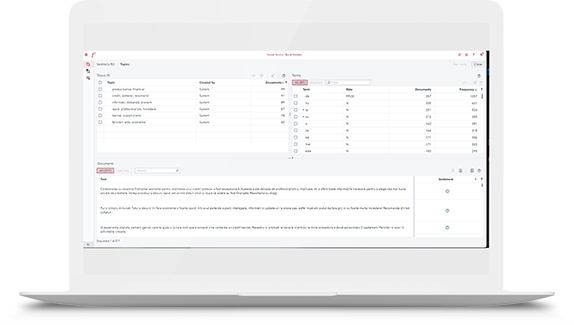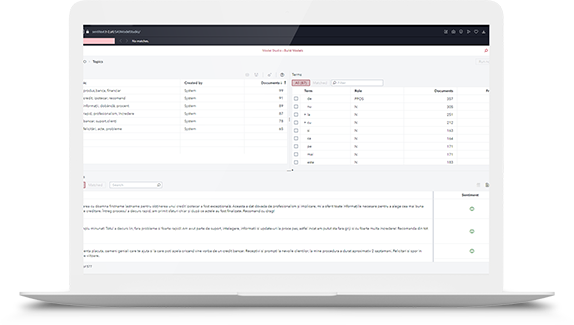Sentitext
Innovative software product for sentiment analysis in Romanian texts

// Description
In the field of computational linguistics, Romanian is a less studied and utilized language. The purpose of the solution Sentitext was to enrich resources for the Romanian language by creating robust lexico-semantic resources in the form of affective lexicons or annotated corpora, which are used for sentiment analysis in texts belonging to the financial domain. These resources are intended for use by individuals working in banking institutions, private pension administrators, leasing companies, insurance companies, and fintech companies. However, the approach to this solution is designed in a way that provides a significant advantage, as it allows for the integration of new language modules from other specialized domains, such as the telecommunications industry, as well as other fields where detailed analysis of available text data is challenging due to the lack of such applications.


Key functionalities
Interactive and user-friendly graphical interface - The solution features an interactive graphical interface that is easy to use, employing point-and-click and drag-and-drop actions. This interface allows the user to utilize the solution without requiring specific knowledge
Text parsing automation - the solution automates the parsing of texts by utilizing concept files from the corpus, thereby obviating the need for user intervention
Sentiment analysis based on a Romanian language corpus - the corpus consists of a collection of concept files containing the words necessary for sentiment analysis. These files are categorized (for example, positive words and phrases, negative, neutral)
Descriptive Visual Reports - provides a variety of comprehensive and visually captivating graphical reports facilitating a deep comprehension of sentiment analysis findings
Caracteristici produs
- Comprehensive, multi-functional support system for implementing advanced Machine Learning and Artificial Intelligence algorithms for text processing, comprising a suite of software solutions installed and configured on a Kubernetes-based virtualization hardware solution, enabling parallel development of company-developed solutions.
- Implementation of advanced Machine Learning and Artificial Intelligence algorithms for text processing supporting the development, publication, and execution of advanced text analysis and machine learning algorithms through a web interface, including continuous testing and model development (Continuous Build / Continuous Integration, Benchmarking).
- Corpus Service manages the project's developed corpus, stored in a persistent container within the product.
- Model Service with AI/ML algorithms utilizing the corpus for sentiment analysis. Models are stored in a persistent container within the product.
- Scoring Service providing textual and sentiment analysis scoring in both programmatic and visual formats, synthesizing the functionality of all modules serving sentiment analysis.
- Training and Workbench Service enabling continuous updating and expansion of the corpus with new functionalities, containing the learning algorithms used for ongoing accuracy improvement.
Beneficiile utilizării soluției
Increase in sales revenue
Technological conformity to global standards
Continuous adjustment to new technologies
Improvement of crisis management
Decrease in risks within non-banking financial organizations by enhancing the ability to analyze each customer interaction
Increase in agility and responsiveness to market/customer needs
Streamlining the process of enhancing services/products in line with customer preferences
Discovery of new marketing strategies
Improvement of customer-oriented services/increase in customer satisfaction
Speeding up response actions to diverse unfavorable organizational situations